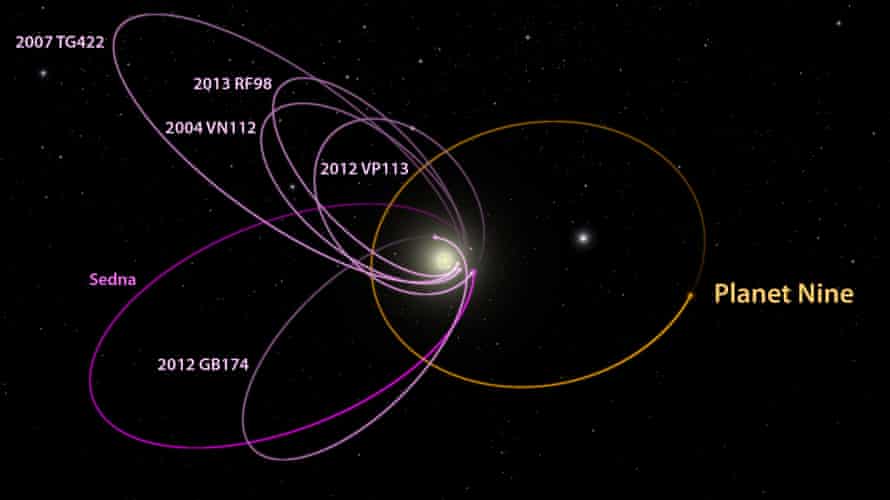Ny Times Reading Quiz 2016/01/21: Ninth Planet May Exist Beyond Pluto, Scientists Report
Equally scientific discipline often does, it began with a "huh?" Some distant objects far beyond Pluto were behaving very oddly. The orbits of a handful of space rocks had aligned for no credible reason. Though stumped at start, astronomers now accept an explanation: a huge ninth planet at the edge of the solar organisation.
If the researchers accept their sums correct, the mysterious new world is 10 times more massive than Earth and up to four times the size. Nicknamed Planet Nine, it moves on an extremely elongated orbit, and takes a staggering x,000 to twenty,000 years to swing once around the sun.
The icy world, if it exists, has evaded detection because information technology is then far away. Scientists at the California Constitute of Technology (Caltech) summate that the closest it comes to the dominicus is 15 times the distance to Pluto. It so heads into uncharted territory, 75 times further out than Pluto, or about 93 billion miles from the sun. A ray of lite would take a week to go there.
"We saw a strange point in the data that meant something odd was going on in the outer solar system," Mike Brown, an astronomer at Caltech, told the Guardian. "All of these distant objects were lined upward in a weird way and that shouldn't happen. We worked through the mundane explanations, but none of them worked out."
Brown and his colleague, Konstantin Batygin, had been investigating claims that 13 icy objects in the Kuiper belt, the region of space where Pluto lies, shared some unusual orbital features that could be explained by the presence of a small planet. They expected to prove the thought wrong, but then made their own curious discovery.
The researchers found that six of the xiii Kuiper belt objects moved on orbits that headed in the aforementioned direction. "If you looked downwards on the solar system and had the sunday in the centre, all of these objects would head out to the 9 o'clock position," said Chocolate-brown. Moreover, their orbits were all tilted at the same angle to the viii known planets in the solar organization.
In scientific discipline, the banal must be ruled out earlier more than exotic explanations tin can be considered. The astronomers wondered whether the Kuiper belt might concord plenty rocky debris from the birth of the solar system to nudge the objects into the same orbits. Only simulations ruled this out: the Kuiper chugalug would need to be 100 times more massive than information technology is.
They next considered a new planet. Their offset computer models had a world circling effectually the Kuiper chugalug objects, only this did non piece of work either. Another explanation came by accident, when they added a massive planet on its ain elongated orbit, which swung out in the opposite direction to the Kuiper belt objects - towards three o'clock in a solar arrangement viewed from in a higher place.
Batygin was sceptical that they had striking on the correct answer. According to his simulations, a big planet in such a bizarre orbit would transport some Kuiper belt objects into orbits that ran perpendicular to the planets in the solar organization. Only the astronomers later found that iv such objects had already been spotted. "When we found that, my jaw sort of striking the floor," said Chocolate-brown. "The simply way to get the orbits lined up is to have a afar, more massive planet shepherding them around." Details appear in the Astronomical Journal.
Chris Lintott, the Oxford professor of astrophysics, and a presenter on The Heaven at Night, said the finding was exciting. "People take proposed the beingness of an extra planet several times over the years, only this is the most detailed and nigh disarming analysis."

"One very interesting affair is that the planet is predicted to be betwixt Earth and Neptune in mass. We see lots of planets this size in our surveys of planets elsewhere in the milky way, and information technology'due south been something of a mystery equally to why our solar system doesn't have its own version of this very common planet type," he added.
But some serious questions remain. "It's not at all clear how you lot form such a big world and move information technology to the outer reaches of the solar arrangement," Lintott said. "Nosotros know the early on history of the solar system was cluttered - and there's prove for a larger planet escaping all together - simply the details are murky at best."
The planet is so large that with sensitive enough telescopes, astronomers should be able to run across it crossing the night sky. The search has already begun with the Subaru telescope in Hawaii. Brown said he would exist surprised if the planet was non found in the adjacent 5 years.
Chocolate-brown, who played a central role in demoting Pluto from planetary status to a more lowly dwarf planet, said the discovery of a 9th planet might be good news for those who are still upset nigh Pluto beingness kicked out of the planetary society. "All those people who are mad that Pluto is no longer a planet can be thrilled to know that there is a existent planet out there still to exist found. Now nosotros can become and find this planet and make the solar system have nine planets once again."
"As a scientist, you should never believe your idea too much until someone else confirms information technology, but we've not been able to come up with any alternative," he said. "Now nosotros've publicly announced it, I'm sure many people will effort their hand at coming up with other explanations."
Source: https://www.theguardian.com/science/2016/jan/20/ninth-planet-solar-system-edge-discovery-pluto
0 Response to "Ny Times Reading Quiz 2016/01/21: Ninth Planet May Exist Beyond Pluto, Scientists Report"
Post a Comment